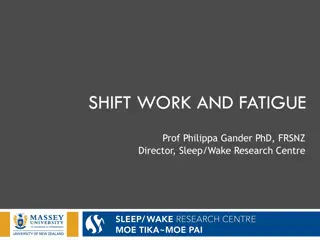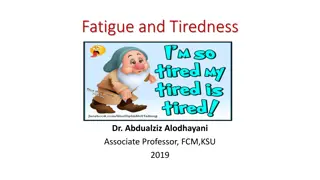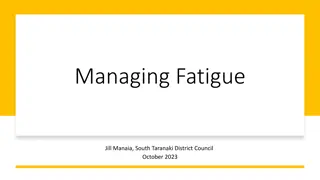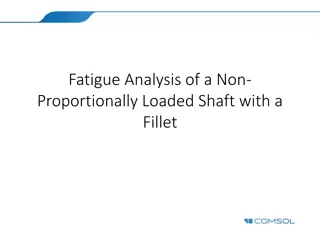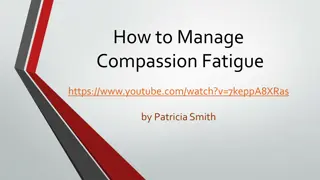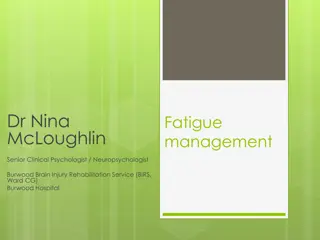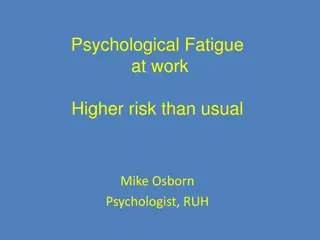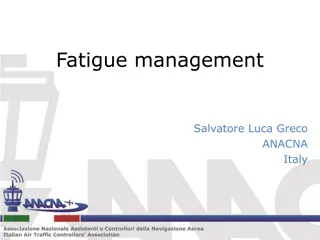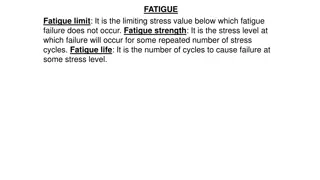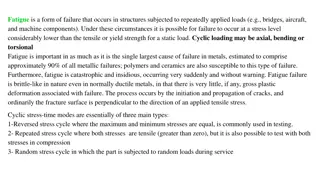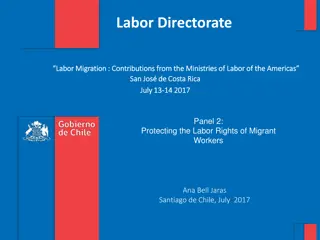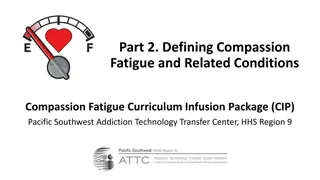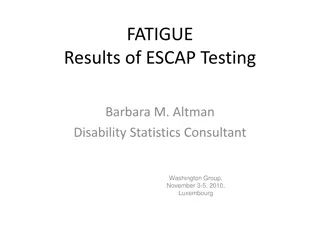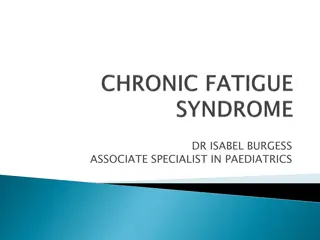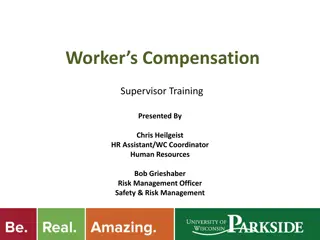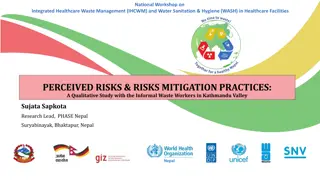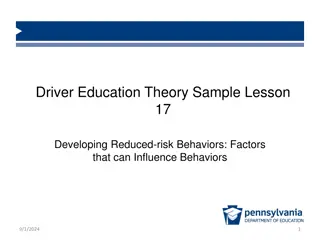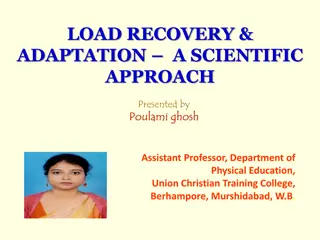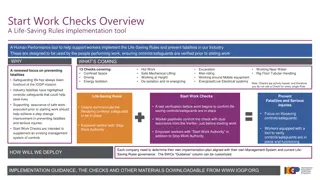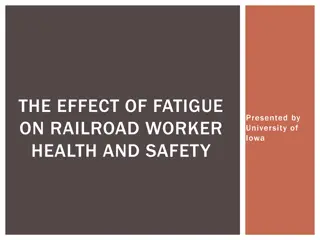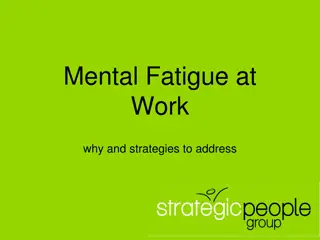Work Fatigue in Chilean Workers: Understanding Impacts and Risk Factors
Fatigue affects a significant portion of the workforce, impacting safety, health, and well-being. This study explores work fatigue in Chilean workers, examining its prevalence, causes, and relationship to occupational accidents. Factors like shift work, workload, sleep disturbances, and health risks contribute to work fatigue, potentially leading to decreased alertness, poor decision-making, and increased accident risk. The research aims to uncover the connections between work fatigue and personal, social, and job-related conditions to enhance workplace safety and employee well-being in Chile.
Download Presentation

Please find below an Image/Link to download the presentation.
The content on the website is provided AS IS for your information and personal use only. It may not be sold, licensed, or shared on other websites without obtaining consent from the author. Download presentation by click this link. If you encounter any issues during the download, it is possible that the publisher has removed the file from their server.
E N D
Presentation Transcript
Thirteenth International Conference on Health, Wellness & Society Work fatigue in Chilean workers: Reviewing comparative evidence Keywords: Work fatigue, safety, risk factors, occupational acccidents. H ctor Vargas-Garrido Vancouver, September 15th, 2023
Work fatigue in Chilean workers Agenda Introduction Method Initial Results a) Work fatigue by age and gender. b) Work fatigue and health and well-being. c) Work fatigue and social and job cachacteristics. d) Occupational accidents and Work Fatigue. Discussion and conclusions
Work fatigue in Chilean workers Project Work fatigue: origin, measurement, and relation to accidents and occupational diseases (Suseso 274-2021). Moyano-D az, Emilio, Vargas-Garrido, H ctor, and M ndez-Campos Doris.
Work fatigue in Chilean workers Introduction Fatigue affects 10% to 33% of the world's population (Pedraz-Petrozzi, 2018). About 78% of the workforce (Haro et al., 2007). Impact on mistakes and occupational accidents (Dawson, 2011). Three types of fatigue are distinguished: physical, mental, and emotional (Frone & Tidwell, 2015). Factors: work-related, individual characteristics, environmental and social (CRSF, 2015). Job factors as causing work fatigue. Shift work (Jehan et al., 2017), scheduled times, excessive workload (Laure et al., 2016). Repetitive tasks, vibrations, inadequate lighting, uncomfortable temperature (Potvin and Bent, 1997; UTS, 2017). Health risks (Garrosa-Hern ndez et al., 2008) and impact workers' safety (Larue, 2016; Serra, 2013). Personal. Sleep disturbances. Shift work sleep disorder (SWSD; Drake et al., 2004). Sleep problems increase occupational accidents (Salminen et al., 2010; Vargas-Garrido et al., 2021).
Work fatigue in Chilean workers Introduction Personal. Health. Workers with work fatigue also present mental (Andrea et al., 2003) and physical health problems. Physical fatigue related to absenteeism (Mart nes, 2019). Fatigue tends to be underestimated by the sufferer. After a first 'alarm' phase, a 'resistance' phase appears, characterized by an apparent recovery (ACHS, 2007). All in all. The above factors can trigger work fatigue and are related to accidents. Work fatigue likely mediates this relationship. Work fatigue could decrease levels of alertness (attention), ultimately leading to poor decision-making (SHF, 2013) and to a risk situation (Dawson et al., 2011). The case of Chile, reinforces these relationships? The country's workers exceed those of OCDE countries in long working hours (Marinakis, 2022). Also, they are among the workers who sleep the least globally (Vargas-Garrido et al., 2021).
Work fatigue in Chilean workers Method Objective. Whether the relationships between work fatigue and personal, social, and job conditions found by research are present in a Chilean workers sample characterized by long working hours and sleep deprivation. Sample. Consisted of 250 workers belonging to a security services company (24% female; 42 years average). Informed consent, and Scientific Ethics Committee. Outcome variable. The Three-Dimensional Work Fatigue Inventory (3D-WFI) by Frone & Tidwell (2015). 18 questions divided into three parts of 6 each. Independent variables. a. Health-related quality of life index (Hennessy et al., 1994). General health self-assessment. b. A total of 35 items aimed at identifying those factors related to work fatigue, such as type of daily workday, daily water and fruit consumption, household chores, sleep quality and quantity, occupational accidents, workplace characteristics (noise, temperature or extreme conditions), quality of life. Analysis plan. Mean comparisons and regression analyses (SPSS software).
Work fatigue in Chilean workers Results 3.12 3.12 3.09 3.1 a.1) Work Fatigue by Gender 2.97 2.93 2.88 2.76 2.72 Table 1 PHYSYCAL MENTAL EMOTIONAL Males (151) Females (59) Overall (250) Averages Work Fatigue, by dimensions and gender Average by dimensions Mental Emotional 2.93 a Overall Fatigue 2.91 Gender Males (191) Physical 3.09a Anova F p ** 2.72 a 26.65 3.12 a 2.88 a Females (59) 3.12 3.04 # ** 3.04 2.94 3.10 a 2.97 a 2.76 a Overall (250) 26.94 Note. No differences between genders; (a) Differences among dimensions; ** p < .01; # p = .06
Work fatigue in Chilean workers Results 3.29 3.24 3.16 3.10 2.98 2.95 2.97 2.86 2.82 2.84 a.2) Work Fatigue by Age 2.75 2.73 2.67 2.32 2.27 Table 2 PSYSICAL MENTAL EMOTIONAL Averages Work Fatigue, by age 18-29 (44) 30-39 (69) 40-49 (75) 50-59 (46) 60-69 (15) Dimensions by age Mental 2,95 Overall Fatigue 2,84 Age Physical 2,82 Emotional 2,75 Anova (inter) F 1.66 p 18-29 (44) n.s. 3,24 a 30-39 (69) 3,29 2,98 6.81 ** 3,17 2,95 2,87 2,48 1.72 n.s. 40-49 (75) 3,16 2,97 2,73 14.07 ** 50-59 (46) 3,10 2,86 2,67 7.73 ** 2,28 a 60-69 (15) 2,84 2,32 5.08 * 1.64 n.s. 2.49 * 1.19 n.s. F (between) p Note. (a) Differences between groups; ** p < .01; * p < .05
Work fatigue in Chilean workers Results Table 3 b) Health and well-being as predictor of fatigue Health and well-being variables as predictors of Fatigue. Physical (a) Mental (b) Emotional (c) Overall (d) p p p p General Health Physical Health Mental Health Health Lost days Sleep quality Sleep quantity Somnolence Water consumption Fruits consumption Life Satisfaction -.22** - - - -.25** -.10* .35** - -.10* - -.18** - - .21** -.15* -.15** .37** - - - -.14* - - .18** -.19** - .31** -.11* - - -.20** - - .17** -.20** -.12* .36** - - - a.- R2 Adjusted = .50, F (5,239) = 49.99, p < .01 b.- R2 Adjusted = .49, F (5,239) = 47.52, p < .01 c.- R2 Adjusted = .37, F (5,239) = 29.34, p < .01 d.- Overall Fatigue. R2 Adjusted = .52, F (5,239) = 53.15, p < .01 ** p < .01; * p < .05
Work fatigue in Chilean workers Results Table 4 c.1) Individual and Social Individual and social variables as predictors of Fatigue. Variables as predictor of fatigue Physical (a) Mental (b) Emotional (c) Overall (d) p p p p Social support Household chores Dependant people Working at home Commuting times - -.21 ** .30 ** - - .12 * -.22 ** .28 ** - - - -.20 ** .33** - - .13 * .37** - - .14 * a.- R2 Adjusted = .15, F (2,247) = 23.08, p < .01 b.- R2 Adjusted = .16, F (3,246) = 17.10, p < .01 c.- R2 Adjusted = .13, F (2,247) = 20.32, p < .01 d.- Overall Fatigue. R2 Adjusted = .18, F (3,246) = 19.03, p < .01 ** p < .01; * p < .05
Work fatigue in Chilean workers Results Table 5 c.2) Job Variables as predictor of fatigue Workplace features as predictor of fatigue Physical (a) Mental (b) Emotional (c) Overall (d) p p p p Workload Emotional Labor Job satisfaction Repetitive tasks Type of working day Length of service Caring for others Daily working hours Income Heat or noisy job Concentration Environm. hazards Workwear a.- R2 Adjusted = .28, F (6,243) = 16.79, p < .01 b.- R2 Adjusted = .27, F (5,244) = 19.40, p < .01 c.- R2 Adjusted = .23, F (4,245) = 19.35, p < .01 d.- Overall Fatigue. R2 Adjusted = .30, F (5,244) = 22.12, p < .01 ** p < .01; * p < .05 .26 ** .14 * -.26 ** - -.12 * .13 * .15 * - - - - - - .24 ** .19 ** -.22 ** .15 * -.16 ** - - - - - - - - .25 ** .23 ** -.16 ** .13 * - - - - - - - - .26 ** .21 ** -.23 ** .15 * -.15 ** - - - - - - - -
Work fatigue in Chilean workers Results Table 6 Averages fatigue comparison between workers with and without labor accidents. Physical d) Occupational accidents and fatigue Mental Emotional Overall 3,48 3,24 3,04 Workplace Accidents Yes (29) 3,25 3,05 2,94 2,72 No (221) 2,90 * n.s. n.s. n.s. p Commuting Accidents Yes (32) 3,45 3,11 2,95 3,17 3,05 2,95 2,73 No (218) 2,91 n.s. n.s. n.s. p * ** p < .01; * p < .05
Work fatigue in Chilean workers Discussion and Conclusion Firstly. No differences between males and females. From highest: physical, mental, and emotional. Mental fatigue to decrease with age (30-39 vs. 60-69). More commuting accidents in people aged 30 to 49, especially women, related to higher work-family conciliation (Moyano-D az et al., 2021). This mechanism could be underlying the greater mental fatigue of workers 30-39 years. Second. Health and quality of life variables are related to different dimensions of workers' fatigue. Similarly, we have corroborated the relationship between fatigue and sleep problems (Jehan et al., 2017). Technical agencies suggest fruit and water consumption as coping mechanism for fatigue (CRSF, 2015). In this study, we have seen they dimmish physical and mental fatigue, respectively.
Work fatigue in Chilean workers Discussion and Conclusion Third. Individual level, household chores contributes the most to fatigue levels (CRSF, 2015), followed by less social support and longer commuting times to work (Gimenez-Nadal, 2019). Reinforcing the need for adequate work-family conciliation. Fourth. Repetitive tasks, emotional labor, and a lower job satisfaction contributes to fatigue (CRSF, 2015; UTS, 2017). However, the schedule associated with higher fatigue is the typical daytime workday (8-18), contrasting with international evidence (shift schedule). Legal working hours are 45 in Chile, where longer than 40 hrs. per week is a risk (Kroenke et al., 2007; Park et al., 2020; Yamauchi et al., 2019). Job seniority and caring for others are related to physical fatigue. Finally, workers with workplace and commuting accidents show higher levels of physical fatigue, corroborating the connection between fatigue and accidents (Dawson et al., 2011). Limitations. Preliminary results of an ongoing research study. More males than females. One specific economic sector, security.
Thirteenth International Conference on Health, Wellness & Society Work fatigue in Chilean workers: Reviewing comparative evidence Thanks for your attention H ctor Vargas-Garrido Vancouver, September 15th, 2023


